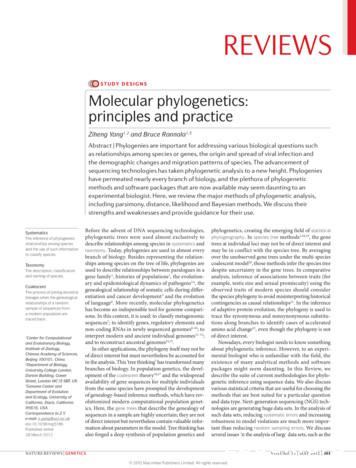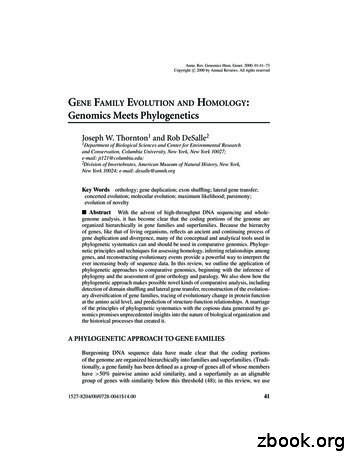Molecular Phylogenetics And Evolution
Molecular Phylogenetics and Evolution 100 (2016) 409–423Contents lists available at ScienceDirectMolecular Phylogenetics and Evolutionjournal homepage: www.elsevier.com/locate/ympevMolecular phylogeny of Panaspis and Afroablepharus skinks (Squamata:Scincidae) in the savannas of sub-Saharan AfricaMaria F. Medina a, Aaron M. Bauer b, William R. Branch c,d, Andreas Schmitz e, Werner Conradie c,f,Zoltán T. Nagy g, Toby J. Hibbitts h, Raffael Ernst i, Daniel M. Portik j, Stuart V. Nielsen k,Timothy J. Colston k, Chifundera Kusamba l, Mathias Behangana m, Mark-Oliver Rödel n, Eli Greenbaum a, aDepartment of Biological Sciences, University of Texas at El Paso, 500 W. University Ave., El Paso, TX 79968, USADepartment of Biology, Villanova University, Villanova, PA 19085, USABayworld, P.O. Box 11347, Humewood 6013, South AfricadDepartment of Zoology, P.O. Box 77000, Nelson Mandela Metropolitan University, Port Elizabeth 6031, South AfricaeNatural History Museum of Geneva, Department of Herpetology and Ichthyology, C.P. 6434, CH-1211 Geneva 6, SwitzerlandfSouth African Institute for Aquatic Biodiversity, P/Bag 10115, Grahamstown 6140, South AfricagRoyal Belgian Institute of Natural Sciences, OD Taxonomy and Phylogeny, Rue Vautier 29, B-1000 Brussels, BelgiumhDepartment of Wildlife and Fisheries Sciences, 210 Nagle Hall, Texas A&M University, College Station, TX 77843, USAiMuseum of Zoology (Museum für Tierkunde), Senckenberg Natural History Collections, Dresden, Königsbrücker Landstr. 159, D-01109 Dresden, GermanyjDepartment of Biology, The University of Texas at Arlington, 501 South Nedderman Drive, Arlington, TX 76010, USAkDepartment of Biology, University of Mississippi, P.O. Box 1848, University, MS 38677, USAlLaboratoire d’Herpétologie, Département de Biologie, Centre de Recherche en Sciences Naturelles, Lwiro, Democratic Republic of the CongomMakerere University, P.O. Box 7062, Kampala, UgandanLeibniz Institute for Evolution and Biodiversity Science (Museum für Naturkunde), Invalidenstr. 43, 10115 Berlin, Germanybca r t i c l ei n f oArticle history:Received 10 October 2015Revised 13 March 2016Accepted 20 April 2016Available online 23 April vergencea b s t r a c tAfrican snake-eyed skinks are relatively small lizards of the genera Panaspis and Afroablepharus. Speciesallocation of these genera frequently changed during the 20th century based on morphology, ecology, andbiogeography. Members of these genera occur primarily in savanna habitats throughout sub-SaharanAfrica and include species whose highly conserved morphology poses challenges for taxonomic studies.We sequenced two mitochondrial (16S and cyt b) and two nuclear genes (PDC and RAG1) from 76 Panaspisand Afroablepharus samples from across eastern, central, and southern Africa. Concatenated gene-tree anddivergence-dating analyses were conducted to infer phylogenies and biogeographic patterns. Moleculardata sets revealed several cryptic lineages, with most radiations occurring during the mid-Miocene toPliocene. We infer that rifting processes (including the formation of the East African Rift System) and climatic oscillations contributed to the expansion and contraction of savannas, and caused cladogenesis insnake-eyed skinks. Species in Panaspis and Afroablepharus used in this study, including type species forboth genera, formed a monophyletic group. As a result, the latter genus should be synonymized withthe former, which has priority. Conservatively, we continue to include the West African species P. breviceps and P. togoensis within an expanded Panaspis, but note that they occur in relatively divergent clades,and their taxonomic status may change with improved taxon sampling. Divergence estimates and crypticspeciation patterns of snake-eyed skinks were consistent with previous studies of other savanna vertebrate lineages from the same areas examined in this study.Ó 2016 Elsevier Inc. All rights reserved.1. IntroductionThere are currently 154 genera and 1602 species assigned to theFamily Scincidae (Uetz and Hošek, 2015, but see Hedges, 2014 for Corresponding author.E-mail address: egreenbaum2@utep.edu (E. 04.0261055-7903/Ó 2016 Elsevier Inc. All rights reserved.an alternative arrangement). Several studies have revealed concealed genetic divergence in multiple lineages of skinks from different regions of the world (Daniels et al., 2009; Engelbrechtet al., 2013; Heideman et al., 2011; Portik et al., 2011; Siler et al.,2011). The family exhibits a wide variety of ecomorphs, but thefossorial/semi-fossorial forms typically have reduced vagility thatcan facilitate population fragmentation and divergence by historical climatic and geographic processes.
410M.F. Medina et al. / Molecular Phylogenetics and Evolution 100 (2016) 409–423The semi-fossorial, African snake-eyed skink genus Panaspiscurrently includes eight savanna and lowland rainforest speciesdistributed throughout sub-Saharan Africa (Uetz and Hošek,2015). In the 20th century, the taxonomic composition of thegenus Panaspis was based on morphological characters, includingskull morphology, head scalation, and distinctive characters inthe lower eyelid (Broadley, 1989; Fuhn, 1969, 1972; Greer, 1974;Perret, 1973, 1975, 1982). As a result, some African and Eurasianskink species were moved back and forth between different scincidtaxa, including Ablepharus, Afroablepharus, Lacertaspis, Leptosiaphos,and Panaspis (Fuhn, 1969, 1970; Greer, 1974; Perret, 1973, 1975).The recurrent allocation of African savanna scincid speciesamong these closely related genera in the 20th century resultedfrom the disparate morphological work of several herpetologists.After the ablepharine (lower eyelid fused with the supercilium)and pre-ablepharine (lower eyelid not completely fused, forminga palpebral slit) eye conditions were discovered (Boulenger,1887), and Fuhn (1969) noted that skull morphology could be usedto delimit scincid taxa, the genus Panaspis was restricted to Africanspecies. Continued use of skull morphology also supported the separation of the family Scincidae into four subfamilies: Acontinae,Feylininae, Lygosominae, and Scincinae (Greer, 1970). Recentmolecular and morphological evidence (Hedges, 2014; Hedgesand Conn, 2012; Skinner et al., 2011) suggested skinks could bedivided into as many as nine families. Although considered controversial, ignored, or rejected by subsequent authors (e.g., Lambertet al., 2015; Linkem et al., in press; Pyron et al., 2013), this newsubdivision continues to support skinks as a monophyletic group(Hedges, 2014). Under a modified version of this classification,the genera Afroablepharus, Lacertaspis, Leptosiaphos, and Panaspisare allocated to the Subfamily Eugongylinae (Hedges, 2014; Uetzand Hošek, 2015).Relying on osteological patterns rather than eye anatomy, Fuhn(1970, 1972) added more skink species with movable lower eyelidsand a transparent disc to Panaspis. Morphological work by Perret(1973, 1975) divided Panaspis species into three groups accordingto general morphology (mabuiform, lacertiform, and sepsinoid).Greer (1974) erected the genus Afroablepharus to accommodateAfrican skinks with an ablepharine eye, and moved all species withmovable lower eyelids and pre-ablepharine eyes to other genera,including semiaquatic species to the genus Cophoscincopus and terrestrial species to the genus Panaspis. As a result, Leptosiaphos wassynonymized with Panaspis based on the movable lower eyelidcharacter, and the only taxon with the pre-ablepharine eye condition was P. cabindae, the type species of Panaspis. Perret (1975)reduced Afroablepharus to a subgenus and described the new subgenus Lacertaspis to accommodate two species (P. reichenowi andP. rohdei) that fitted his lacertiform description from two yearsearlier. Broadley (1989) revised the genera in question andrestricted Panaspis to species residing in African savannas andhaving ablepharine or pre-ablepharine eyes. He then restoredLeptosiaphos to full genus rank for forest and montane grasslandspecies that had a movable lower eyelid. Lastly, he erected a newsubgenus, Perretia, to accommodate a newly described species,Leptosiaphos (Perretia) rhomboidalis, which had distinctive cephaliclepidosis. A recent revision by Schmitz et al. (2005) recognizedAfroablepharus, Lacertaspis, and Leptosiaphos as distinct genera.Although Schmitz et al. (2005) gave Afroablepharus full-genusrank, insufficient sampling did not fully resolve the genus-levelboundaries between Afroablepharus and Panaspis, as only two species each of Afroablepharus and Panaspis were assessed, and samples of the type species of the latter genus (Panaspis cabindae)were not available at that time. The included species of Panaspis(P. breviceps and P. togoensis) were also not ideal representatives,because they have unique morphological characters and habitatpreferences that differ from most remaining members of the genus.This taxonomic arrangement is currently recognized in a recentreptile atlas of South Africa (Bates et al., 2014) and the ReptileDatabase (Uetz and Hošek, 2015). In this study, our objective isto investigate the monophyly of Afroablepharus and Panaspis, andclarify their relationship to closely related African genera, including Lacertaspis and Leptosiaphos. Afroablepharus wahlbergi is themost common and widespread snake-eyed skink in sub-SaharanAfrica, but its distribution is disjunct and poorly known (Branch,1998; Fuhn, 1970; Spawls et al., 2002). Greer (1974) designatedA. wahlbergi as the type species of Afroablepharus. The type localitywas vaguely defined by Smith (1849)—as ‘‘country to the eastwardof the Cape Colony,” but it is likely to be in the southeastern part ofKwaZulu-Natal (Broadley and Howell, 1991). The species has beenreported from mainly southern and eastern African countries fromSouth Africa to Kenya, and even Namibia (Fuhn, 1970; Jacobsenand Broadley, 2000; Spawls et al., 2002). Other sub-Saharan Africanendemics are known to have a similar widespread distributionover savanna and/or woodland habitats, including birds (Voelkeret al., 2012), anurans (Evans et al., 2015; Zimkus et al., 2010), mammals (Gaubert et al., 2005), insects (Simard et al., 2009), and otherskinks (Portik and Bauer, 2012).Herein, we examine evolutionary relationships of skinks in thegenera Panaspis and Afroablepharus. We follow the General LineageConcept (de Queiroz, 1998, 2007; de Queiroz and Gauthier, 1990),which recognizes species as separately evolving lineages. With thisspecies concept, we reject the use of subspecies as natural groupsand use molecular data sets to identify separately evolving species.Our concatenated analyses are used to address the following questions: (1) Are Afroablepharus and Panaspis distinct, reciprocallymonophyletic lineages? (2) What is the extent of cryptic speciationwithin the Afroablepharus wahlbergi complex? (3) When didAfroablepharus/Panaspis species diversify? and (4) Can diversification of Afroablepharus/Panaspis species be linked to climatic andbiogeographic events?2. Materials and methods2.1. Taxon samplingSpecimens of the genera Panaspis and Afroablepharus were collected from multiple localities in sub-Saharan Africa, and 76 samples were sequenced (Table 1, Fig. 1). Additional comparativematerial was obtained from collections listed by Sabaj Pérez(2013). We generated 75 sequences of 16S, 70 of cyt b, 65 of PDC,and 41 of RAG1. Two species of Trachylepis, one species of Typhlosaurus (Scincidae) and Cordylus marunguensis (Cordylidae) wereused as outgroups to root the trees. Additional sequences of closelyrelated genera (Lacertaspis, Leptosiaphos, and Mochlus) were alsosequenced or included from GenBank (Table 1).2.2. PCR amplification and sequencingThe DNA of alcohol-preserved muscle or liver tissue sampleswas extracted using the Qiagen DNeasy Blood and Tissue Kit(Valencia, CA), or the IBI DNA Extraction Kit (Shelton Scientific,Peosta, IA). Two mitochondrial (16S and cyt b) and two nuclear(PDC and RAG1) genes were amplified (Table 2) in 25 lL PCRs, withan initial denaturing temperature of 95 C for 2 min, followed bydenaturation at 95 C for 35 seconds (s), annealing at 50 C for35 s, and extension at 72 C for 95 s with 4 s added to the extensionper cycle for 32 or 34 cycles (for mitochondrial or nuclear genes,respectively). The PCR amplicons were visualized with a 1.5% agarose gel with SYBRsafe gel stain (Invitrogen, Carlsbad, CA), and theseproducts were purified with Agencourt AMPure XP magnetic bead
411M.F. Medina et al. / Molecular Phylogenetics and Evolution 100 (2016) 409–423Table 1Field numbers and localities for specimens used in genetic analyses. DRC Democratic Republic of Congo, E east, Moz Mozambique, N north, NW northwest,SW southwest, S south, SA South Africa.SpeciesField numberCollection numberLocality16Scyt bPDCRAG1Cordylus marunguensisTrachylepis megaluraTrachylepis striataTyphlosaurus brainiTyphlosaurus brainiLacertaspis chriswildiLacertaspis gemmiventrisLacertaspis gemmiventrisLacertaspis reichenowiLacertaspis rohdeiLeptosiaphos blochmanniLeptosiaphos koutouiLeptosiaphos meleagrisLeptosiaphos sp.Leptosiaphos sp.Mochlus aferAfroablepharus africanusAfroablepharus africanusAfroablepharus africanusAfroablepharus annobonensisAfroablepharus annobonensisPanaspis brevicepsPanaspis brevicepsPanaspis brevicepsPanaspis brevicepsPanaspis cabindaePanaspis cabindaePanaspis cabindaePanaspis cabindaePanaspis cabindaePanaspis cabindaePanaspis cabindaePanaspis cabindaeAfroablepharus maculicollisAfroablepharus maculicollisAfroablepharus maculicollisAfroablepharus maculicollisAfroablepharus maculicollisAfroablepharus maculicollisAfroablepharus sp. EthiopiaAfroablepharus sp. Katanga 1Afroablepharus sp. Katanga 1Afroablepharus sp. Katanga 2Afroablepharus sp. Katanga 2Afroablepharus sp. Katanga 2Afroablepharus sp. Katanga 2Afroablepharus sp. Katanga 2Afroablepharus sp. LimpopoAfroablepharus sp. LimpopoAfroablepharus sp. MalawiAfroablepharus sp. MalawiAfroablepharus sp. MozambiqueAfroablepharus sp. MozambiqueAfroablepharus sp. MozambiqueAfroablepharus sp. MozambiqueAfroablepharus sp. MozambiqueAfroablepharus sp. MozambiqueAfroablepharus sp. MozambiqueAfroablepharus sp. MozambiqueAfroablepharus sp. MozambiqueAfroablepharus sp. MozambiqueAfroablepharus sp. MozambiqueAfroablepharus sp. MozambiqueAfroablepharus sp. MozambiqueAfroablepharus sp. MozambiqueAfroablepharus sp. MozambiqueAfroablepharus sp. MozambiqueAfroablepharus sp. MozambiqueAfroablepharus sp. MozambiqueAfroablepharus sp. NamibiaAfroablepharus sp. NamibiaAfroablepharus sp. Tanzania 1Afroablepharus sp. Tanzania 1EBG 2993EBG 1409EBG 1407AMB 6338AMB 6340–RCD 13251RCD 13255E56.12–EBG 1610–ELI 2844––E56.17–Pm3E62.17An15An9ELI 558MM 106MM 105–WRB 804PM 050PM 049WRB 810ANG 21ELI 1722ANL 52MBUR 2128ANG 421MBUR 02843MBUR 02848MCZF 38848MCZF 38790MCZF 38733TJC 264ELI 294ELI 295WRB 575WRB 576JHK 26WRB 0047WRBNimb083MCZ-A 27176MCZ-A 27177WRB 568WRB 570WC 1251WC 1249WC 1169WC 1186SVN 693WRB 886WC 1358ENI 038WC 1051WC 1067WC 1133WC 1161WRB 855WRB 856WC 1317WC 1404ENI 037DMP 187AMB 7634WRB 567WRB 0021WRB 0026UTEP 20374UTEP 21195UTEP 21172CAS 214579CAS 214581ZFMK 75735CAS 207854CAS 207858–ZFMK 75382UTEP 21177MNHN 2001.0697UTEP 21178ZFMK 69552ZFMK 75381ZFMK 54317Uncatalogued–BMNH, Uncatalogued––UTEP 21176ZFMK 87663ZFMK 87662ZFMK 75380PEM R20256UncataloguedUncataloguedPEM R21594PEM R19467UTEP 21173MTD 48612UncataloguedPEM R20475UncataloguedUncataloguedCAS 234188CAS 234135CAS 234099–UTEP 21174UTEP 21175PEM R17454PEM R17455UncataloguedPEM R20327––CAS 248791PEM R20247PEM R20800PEM R20561No voucherPEM R20565PEM R20566–PEM R20591UncataloguedUncataloguedNo voucherPEM R20557No voucherPEM R20558PEM R20569PEM R20576UncataloguedUncataloguedUncataloguedMVZ 266148MCZ R183767Uncatalogued––Pepa, Katanga, DRCLwiro, South Kivu, DRCLwiro, South Kivu, DRCRooibank, Erongo Region, NamibiaRooibank, Erongo Region, NamibiaTchabal Mbabo, CameroonBioko Island, Equatorial GuineaBioko Island, Equatorial Guinea–Mt. Nlonako, CameroonBichaka, South Kivu, DRCMeiganga, Adamaoua Plateau, CameroonRwenzori Mountains National Park, UgandaMt. Nlonako, CameroonMt. Nlonako, CameroonKiyawetanga, KenyaPríncipe, Gulf of GuineaMontalegre, Príncipe, Gulf of GuineaPríncipe, Gulf of GuineaAnnobon, Gulf of GuineaAnnobon, Gulf of GuineaByonga, South Kivu, DRCMawne, CameroonMawne, CameroonMt. Nlonako, CameroonSoyo, NW AngolaLuango-Nzambi, Bas-Congo, DRCLuango-Nzambi, Bas-Congo, DRCRiverine Forest, Bengo, AngolaLagoa Carumbo, AngolaBombo-Lumene Reserve, Kinshasa, DRCKimpa Vita Uni Campus, Uíge, N AngolaS Leba Pass, Huila District, SW AngolaBenero Campsite, near Jamba, AngolaPhalaborwa, Limpopo, SAPhalaborwa, Limpopo, SAFarm Nooitgedacht, Limpopo Province, SAFarm Vrienden, Limpopo Province, SAFarm Vrienden, Limpopo Province, SAOromia, western EthiopiaMulongo, Katanga, DRCMulongo, Katanga, DRCKalakundi Copper Mine, S Katanga, DRCKalakundi Copper Mine, S Katanga, DRCKisanfu Camp, Katanga, DRCFungurume Camp, Katanga, DRCNW ZambiaHoedspruit, Limpopo, SAHoedspruit, Limpopo, SASombani Trail, Mt. Mulanje, MalawiLikabula Station, Mt. Mulanje, MalawiEcofarm, Chemba, MozEcofarm, Chemba, MozBoabab Ore Mine, Masamba, MozBoabab Ore Mine, Masamba, MozGorongosa National Park, MozRuoni Hill S, Tete Province, MozQuiterajo, Cabo Delgado, MozMocimboa da Praia, Cabo Delgado, MozNW of Rapale, Nampula, MozE of Ribuae, Nampula, MozNW of Mecuburi, Nampula, MozRapale, Nampula, MozSyran graphite mine, Balama, MozSyran graphite mine, Balama, MozPemba, Cabo Delgado, MozPemba, Cabo Delgado, MozQuirimbas National Park, MozSerra Jeci, MozSesfontein, NamibiaOtavi, NamibiaArusha, TanzaniaArusha, 8676111111223333444445(continued on next page)
412M.F. Medina et al. / Molecular Phylogenetics and Evolution 100 (2016) 409–423Table 1 (continued)SpeciesField numberCollection numberLocality16Scyt bPDCRAG1Afroablepharus sp. Tanzania 2Afroablepharus sp. Tanzania 2Panaspis togoensisPanaspis togoensisPanaspis togoensisPanaspis togoensisPanaspis togoensisP
Molecular phylogeny of Panaspis and Afroablepharus skinks (Squamata: Scincidae) in the savannas of sub-Saharan Africa Maria F. Medina a , Aaron M. Bauer b , William
Lecture 18 . Molecular Evolution and Phylogenetics . 6.047/6.878 - Computational Biology: Genomes, Networks,
Combinatorial Phylogenetics of Reconstruction Algorithms by Aaron Douglas Kleinman Doctor of Philosophy in Mathematics Designated Emphasis in Computational and Genomic Biology University of California, Berkeley Professor Lior Pachter, Chair Phylogenetics is the study of the evolutionary history
ing. The literature of molecular phylogenetics is large and complex23,24; the aim of this Review is to provide a starting point for exploring the methods further. Phylogenetic tree reconstruction: basic concepts A phylogeny is a tree containing nodes that ar
The journal Molecular Biology covers a wide range of problems related to molecular, cell, and computational biology, including genomics, proteomics, bioinformatics, molecular virology and immunology, molecular development biology, and molecular evolution. Molecular Biology publishes reviews, mini-reviews, and experimental and theoretical works .
Predicting adaptive evolution Robin M. Bush OPINION Phylogenetic trees reconstruct past evolution and can provide evidence of past evolutionary pressure on genes and on individual codons. In addition to tracing past evolutionary events, molecular phylogenetics might also be used to predict future evolution. Our ability to verify adaptive
Jan 31, 2011 · the molecular geometries for each chemical species using VSEPR. Below the picture of each molecule write the name of the geometry (e. g. linear, trigonal planar, etc.). Although you do not need to name the molecular shape for molecules and ions with more than one "central atom", you should be able to indicate the molecular geometryFile Size: 890KBPage Count: 7Explore furtherLab # 13: Molecular Models Quiz- Answer Key - Mr Palermowww.mrpalermo.comAnswer key - CHEMISTRYsiprogram.weebly.comVirtual Molecular Model Kit - Vmols - CheMagicchemagic.orgMolecular Modeling 1 Chem Labchemlab.truman.eduHow to Use a Molecular Model for Learning . - Chemistry Hallchemistryhall.comRecommended to you b
Xiangrun's Molecular sieve Email:info@xradsorbent.com Tel:86-533-3037068 Website: www.aluminaadsorbents.com Molecular sieve Types 3A Molecular sieve 4A Molecular sieve 5A Molecular sieve 13X Molecular sieve PSA Molecular Sieve Activated zeolite powder 3A Activated zeolite powder 4A Activated zeolite powder 5A
concerted evolution; molecular evolution; maximum likelihood; parsimony; evolution of novelty Abstract With the advent of high-throughput DNA sequencing and whole-genome analysis, it has become clear that the coding portions of the genome are organized hierarchically in gene families and superfamilies. Because the hierarchy





















